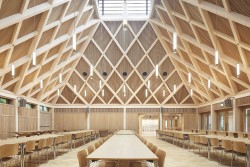Maccreanor Lavington recently completed a refectory at Ibstock Place School, an independent, co-educational day-school for over 1,200 four- to 18-year-old pupils in south-west London.
The building replaces its conservatorystyle, acoustically flawed predecessor at the heart of the landscaped school campus. An intricate timber roof structure conveys intimacy and grandeur to the interiors, where natural light and orchard views bestow a calm and contemplative quality upon the warm, convivial space. Rising to three glazed lanterns, the roof supports a simple natural ventilation strategy and defines the uses below.
As the largest element the building, the roof’s geometry and construction were a focus for aesthetics and performance in which the use of timber became instrumental: working with structural consultants engineersHRW, Maccreanor Lavington developed a structure that provides a clear order and scale to the building’s volumes. The refectory’s ceilings are defined by a striking spruce glulam lattice structure, with oak panelling insets incorporating acoustic absorption. The glulam elements are constructed on a diamond grid, although, structurally, they owe much to a traditional cut timber roof.
“There is a hierarchy of elements with the primary rafters spanning between a steel ring-beam at the eaves and a timber ring-beam at the lantern or the corner rafters,” says Greg Nordberg from engineersHRW. “The primary rafters support secondary and tertiary elements that form the rest of the lattice. The secondary elements are sized to match the primaries, providing the desired pattern within the space. Using the rafters as a two-way spanning diagrid was also considered in detail. This format reduced the stresses on the individual members however the more onerous connections meant equivalent sized sections would be required. The stiffness of the roof geometry and the truss action of the roof were considered with separate models to provide an envelope of forces for element design and examine alternative load paths for disproportionate collapse.”
Between the deep rafters sits a subsidiary grid of smaller glulam sections. The striking graphic arrangement of the rafters into this ‘tartan’ provides a rational and attractive framework for oak batten infill panels with acoustic backing, which were prefabricated and fully finished offsite. The geometry was developed to limit the panels to just four different shapes across the building and make them a manageable size for manual handling.
The millimetre precision of the glulam allowed for the development and construction of complex connections, enabling the assembly of roof pitches set to different angles. These connections formed the interface between the timber roof and the steel structure that supports them. The galvanised plate connections were developed by engineersHRW and specialist contractors Constructional Timber considering both the structural requirements and the ability for the large timber elements to be installed.
“With the restricted site access all deliveries were arranged using rigid vehicles only, which was challenging when the hip-beams were nearly 11m long and weighing 1.2 tonnes,” says Andrew King, Director, Constructional Timber. “For the installation sequence it was key to fix the level of the lantern beams off the temporary loadbearing scaffold supplied by the main contractor. The lantern beams were levelled to the correct height before the twin hip-beams were craned into position. The members were all supplied fully protected and with their fire treatment applied so to reduce site time and potential for damage.”
Ensuring long-lasting harmony in the different timber finishes – spruce glulam structure, oak timber linings and joinery and oak engineered wood floors – was important. We were keen to control the aesthetic over time and were mindful that the softwood glulam would redden from sunlight exposure. We wanted to avoid the space adopting an orangey ‘sauna’ look and a strident contrast with the more muted hue of the aged oak finishes.
For this, we worked closely with timber coatings’ company Renner to do accelerated ageing of the different glulam finishes in a lab, developing a white tinted fire-proofing finish that would remain UV-stable.
To read full article and for more news, check out the latest Offsite Magazine









